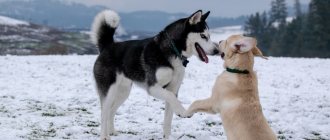Without correctly understanding the language of dogs, it is difficult to establish contact with your pet and instill in him the necessary behavioral skills. Of course, there is no universal translator or special dictionary for deciphering dog language, because each dog is individual. But there are certain signs by which you can draw a conclusion about the dog’s mood, having learned to interpret them correctly. If you want to learn how to understand your pet correctly, we recommend reading this review.
Dog tongue
From their ancestors, wolves, dogs inherited a certain system of expressing their emotions. To communicate with relatives and people, they use facial expressions, postures, and voice. Dogs are social creatures and perceive family members as a pack where hierarchy rules.
Important! Dogs never lie or hide their true feelings. Carefully observe the habits and manners of the animal at home and on walks. Analyze when the dog growls, barks, wags its tail, and you will accurately learn to understand your pet.
By correctly interpreting what the dog wants to convey to us, carefully observing gestures, postures, and body movements, you can understand how the pet feels and what its mood is. This will allow you to predict his behavior and react in a given situation.
Dogs experience:
- joy, goodwill;
- fear, stress, tension;
- aggression, irritation;
- dominance, readiness to attack;
- submission, humility.
Our little brothers express their emotions with their eyes, tail, certain poses, movements, voice, and facial expressions. They make many sounds and gestures, which can be used to determine the pet’s further intentions.
Silent Maw
When the animal is calm and relaxed, its mouth may be completely closed or slightly open. The lips of a frightened animal stretch slightly at the corners with the mouth completely closed. By showing their front teeth, dogs show a submissive smile, expressing respect for their owner. When the dog behaves aggressively, it also exposes its teeth, but folds appear on its muzzle. If the corners of the dog's lips are adjacent to each other and all the teeth are visible, the animal is frightened and is preparing to repel an attack.
Learning to understand your dog
So that there is no misunderstanding between you and the dog, we will decipher the signs of the dog’s language. To extract more information about the animal's state, feelings and intentions, pay attention to all of your pet's behavior at the same time. Assess the condition comprehensively, this is the only way you can understand your pet.
Muzzle
Dogs' faces have different shapes and sizes. But every little face, regardless of breed, will tell its owners about the dog’s feelings.
Our little brothers express their emotions with their eyes. The expression, direction of gaze, and eye size change. So, if the pet is calm and balanced, his eyes will be in their usual state, his gaze will be calm.
If the dog is threatened by something, he is excited, scared, his eyes increase in size relative to their normal state. The pupil is dilated.
If the dog is interested in something or scared, its eyes appear smaller. If the pet is sick, feels unwell, the expression in the eyes becomes sad, the look dims. The dog looks sideways and reacts sluggishly to stimuli. A sideways glance speaks of submission, indicating that the dog has realized his guilt after disobedience.
Advice! If you feel that your pet is friendly towards you, do not look the dog in the eyes. This signal is perceived as a threat. If the dog looks with a “frozen” gaze, the dog is wary, slowly turn your head away and avert your eyes.
If a dog looks away, closes its eyes, turns away its muzzle when meeting its relatives, this means that it does not pose a threat and will not show aggression without a reason.
As a rule, dogs rarely look directly into each other's eyes, as this is a threat signal.
If the dog looks at you with a calm expression on its muzzle and tilts its head, the animal trusts and hopes for understanding. Frequent blinking when looking at any object is a call to play.
Growl
Such sounds do not always indicate anger or aggression. The animal may growl out of fear. Dogs can growl to react to actions that are unpleasant or painful for them (pricks, claw trimming). With similar sounds they can react to the unknown (strangers entering the house) or protect their resources (toys, food).
“Fisherman’s” sandals and 4 more pairs of shoes without heels, in which your feet will not get tired
Aquarius - listen to intuition: forecast for all signs for the spring equinox
They wanted to clear the roof of snow and almost ended up under it: video
However, growling can also be used in a positive way - in playing with other animals, eating bones.
Body position
Animals also use their bodies to express emotions or intentions. In a calm state, the muscles are relaxed, not tense, and the dog does not take positions uncharacteristic of its usual behavior. Movements are free, natural, body weight is evenly distributed on four paws.
Attracting the owner's attention, inviting him to play, the dog jumps, vigorously wagging its tail, whines softly, using various intonations, sits on its front legs, raising its croup, or is constantly in motion. This behavior indicates that the animal is friendly and in a good mood.
If the dog is scared, feels aggression from his relatives, he is tense, his movements are constrained. The pet freezes in place, bends its paws, lies on the ground, does not respond to stimuli, takes unnatural poses, focusing on a frightening object. When frightened, the dog does not make unnecessary movements, trying to appear smaller, and can run away from the owner.
Fear is indicated by muscle tremors, flattened ears, and tail. If the dog whines, cannot find a place for himself, constantly changes his location in the house or apartment, takes uncharacteristic poses, whines - he is experiencing discomfort, has suffered stress, or the pet is in pain.
The dog stretches forward on tense paws, stands straight, muscles tense - the dog challenges, showing its superiority. Perhaps the animal feels aggression and if two dogs take similar poses, it will end in a fight.
If the dog lies on its back, stretches out its paws, wags its tail, the pet trusts you, demonstrating its obedience, and in relation to its relatives this means recognizing the authority of another dog.
A raised paw is a signal of uncertainty and wariness. If the pet behaves quietly, lies down and rests its head on its front paws, it is completely subordinate to the owner or another dog.
What else affects a puppy's behavior?
Body language depends not only on the health of the animal, but also on its mood and the fulfillment of its needs. And if you are sure that your puppy is healthy, but is behaving unusually, it may be due to psychological reasons.
“Bad habits” can be different: the puppy chews on the owner’s things, howls alone, shows cowardice, picks up and eats garbage on the street. However, most often they are all caused by previous experience, lack of physical and emotional stress and weakness of the dog’s nervous system.
To prevent this, do not create situations for the manifestation of bad habits: do not let the dog get overexcited, switch attention to yourself, and always keep the puppy busy with new activities.
Barking
The timbre of the voice and the nature of the barking determine the dog’s state and intentions. Barking is a kind of dog language that is used to attract attention. It can mean joy, fear, aggression, threat, fear. The timbre and character of barking changes depending on the emotional state and situation. But barking does not always mean aggression or readiness to attack.
Important! The more aggressive the dog’s mood, the lower the timbre of the voice. If the dog is scared, the stronger and higher the sound of barking will be.
A quiet grunt or growl is a sign of dominance and may mean that the dog wants to show aggression.
Squealing, squeaking, howling, whining - the dog is scared, is in an unpleasant psychological, physical situation, and expresses his resentment. A high-pitched barking sound means the dog is in pain. A dog can howl from loneliness, melancholy, or inattention.
A prolonged vibrating high-pitched sound, squeaking, whining, accompanied by other emotions - signals of surprise, joy, attracting attention. Dogs can squeak when they are impatient, for example, while waiting to go for a walk or begging for a treat.
"Sensible" tail
There is an opinion: if a dog wags its tail, it is friendly and open to communication. However, this is not entirely true. If a dog wags his tail from side to side, while moving his whole body, he is really happy to see his owner. But if the tail is lowered or clamped between the hind legs, the animal is nervous. A high tail indicates that the dog is alert. If the tail is tense and only the tip moves, the dog is showing hostility and is ready to attack.
Does your dog snore?
Normal snoring, which happens to many people, is harmless in most cases. But it may also indicate some problems. If your dog snores outside instead of next to you, it may seem cute. However, a pet snoring loudly under your ear can be quite annoying.
Don't you like dog snoring? Then immediately refuse to purchase some dog breeds, since they cannot help but snore due to their physiological characteristics. Brachycephalic dogs, such as bulldogs, Pekingese and pugs, are prone to snoring because their short muzzles cause breathing problems. But even in the case of such breeds, it is worth monitoring whether the frequency and level of snoring in your animal increases.
Other breeds may snore due to dust, cigarette smoke, that is, allergic reactions. More serious problems may include sleep apnea, hypothyroidism and excess weight.
Found a violation? Report content
How do dogs talk to each other?
Dogs are social animals that need constant communication and attention. They communicate with each other using the same gestures and sounds as with humans. The only difference is a better understanding of each other and one significant difference - smells.
A high intonation of barking expresses positive emotions, and a low intonation expresses negative emotions.
Marks left by pets are one of the ways to communicate with each other. That is why, every time they meet, dogs go through a mandatory sniffing ritual that can say more than a set of sounds and gestures.
In conclusion, I would like to note that understanding a dog’s language makes life much easier. By understanding the signals of your four-legged friend, you can avoid danger and help in time in case of trouble.
Remember that pets also have difficulty understanding human speech. This is why it is so important to teach them basic commands to control unwanted behavior.
Reverse breathing
Sometimes dogs can make a buzzing, startling noise, also called a “reverse sneeze.” Hearing this sound may make you think your dog is choking or choking. This is usually a short-term phenomenon and does not pose any danger.
Haircuts were not Aunt Tanya’s thing: Menshova remembered her first “stylist”
Apple does not leave the market in Russia, agreeing to install Russian software
Many lines and two branches: we read the marriage lines under the little finger
Sounds similar to snorting, coughing and gagging at the same time are caused by irritation of the throat and soft palate. This phenomenon may also indicate anxiety, a foreign object in the throat, viruses and allergies. If the sound is not caused by a sharp pull on the leash and occurs frequently, you should consult a veterinarian.











